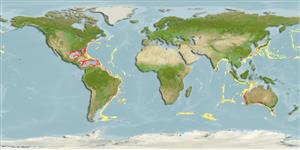Bathynomus giganteus Milne-Edwards, 1879
Giant isopod| Native range | All suitable habitat | Point map | Year 2050 |

|
| This map was computer-generated and has not yet been reviewed. |
| Bathynomus giganteus AquaMaps Data sources: GBIF OBIS |
Изображение на Google |
No photo available for this species.
Классификация / Names народные названия | синонимы | CoL | ITIS | WoRMS
Malacostraca | Isopoda | Cirolanidae
Environment: milieu / climate zone / пределы глубины / distribution range экология
батидемерсальный; пределы глубины 310 - 2300 m (ссылка 3113), usually 365 - 730 m (ссылка 80749). Deep-water
Distribution страны | регионы FAO | Ecosystems | места находок | интродукции
Indo-West Pacific and Western Atlantic.
Length at first maturity / Size / Weight / Возраст
половая зрелость: Lm 18.0 range ? - ? cm Max length : 50.0 cm TL самец/пол неопределен; (ссылка 99323)
Краткое описание морфология
Life cycle and mating behavior половая зрелость | размножение | нерест | Eggs | Fecundity | Larvae
Основная ссылка
ссылки | координатор | соавторы
Schotte, M., B.F. Kensley and S. Shilling 1995 World list of marine, freshwater and terrestrial crustacea isopoda. National Museum of Natural History Smithsonian Institution: Washington D.C., USA. Http://www.nmnh.si.edu/iz/isopod/ [Accessed 07/03/01]. (ссылка 3113)
Статус Красного Списка МСОП
(ссылка 130435: Version 2025-1)
Статус СИТЕС (ссылка 108899)
CMS (ссылка 116361)
Угроза для людей
Использование человеком
рыболовство: интереса не представляет
| FishSource |
инструменты
дополнительная информация
ресурсы в Интернет
BHL | BOLD Systems | CISTI | DiscoverLife | FAO(Publication : search) | Fishipedia | GenBank (Геном, Нуклеотид) | GloBI | Gomexsi | Google Books | Google Scholar | Google | PubMed | Tree of Life | Wikipedia (Вперёд, поиск) | Zoological Record


